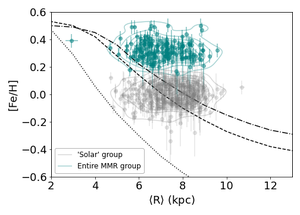
An international team of astronomers led by Dr Maria Luiza Linhares Dantas, a postdoctoral researcher at the Nicolaus Copernicus Astronomical Centre (CAMK), have made an exciting discovery of a set of 171 old super-metal-rich stars currently located in the solar vicinity. These stars have an estimated age of about 8 billion years. They have chemical elements in amounts 1.5 to 3 times greater than what is found in the Sun. The team determined that these stars were formed between 2 and 4 kpc away from the Galactic centre. However, they are now located at distances between 6 and 9 kpc from the Galactic centre (the Sun itself is at 8 kpc). These metal-rich stars moved away from their birthplace because of radial migration.
Imagine that stars in the Milky Way are like people living in a city. Just as people can move from one neighbourhood to another, stars may move from one place to another within the Galaxy. This movement can occur because of dynamic effects created by the influence of other stars or structures in the Galaxy, such as the spiral arms. This process, called radial migration, because it changes the radius where the star is located, can change the overall appearance of a galaxy and cause the mixture of old and new stars originally born in different regions.
In their analysis, the team used chemical abundances from the Gaia-ESO spectroscopic survey. They also calculated the stars' ages, velocities, and orbits inside the Galaxy. The distribution of the velocities shows a high dispersion, a sign of previous dynamic perturbations. Another similar sign of previous perturbations is that, in their orbits, the stars can reach distances of more than 500 pc above or below the Galactic plane. Stars in the Galactic thin disc tend to stay within a distance of up to 300 pc of the plane. A comparison with theoretical models also shows that the solar vicinity was not as metal-rich as these stars were at the time they were formed (see Fig. 1). The analysis of all these properties led to the discovery that these super-metal-rich stars likely originated in the inner regions of the Milky Way and then migrated to their current position.
The results are particularly noteworthy because they challenge the traditional understanding that metal-rich stars should be young objects. The discovery of these stars provides new insight into the chemical and dynamic evolution of the Galaxy. These results were recently published in the journal Astronomy & Astrophysics.
With these findings, the researchers also delved into the complex behaviour of the light element lithium in such metal-rich stars. This fragile element can be formed by various sources but can also be easily destroyed inside stars. In a groundbreaking study, the researchers discovered that the amount of lithium in stars that have migrated from the inner regions of our Galaxy is lower than expected because of how rich in metals they are. This finding suggests that the use of lithium abundances from old dwarf stars to measure the current amount of lithium in the interstellar medium is inaccurate. This exciting discovery opens new doors for understanding the formation and destruction of lithium in the Universe. The lithium results were published in a second article, also in the Astronomy & Astrophysics scientific journal.
The research was carried out in collaboration with dr hab. Rodolfo Smiljanic, CAMK professor, was supported by the National Science Center through the Sonata Bis project "Playing CHESS with stars".
Paper I: The Gaia-ESO Survey: Old super-metal-rich visitors from the inner Galaxy
Text by Maria Luiza L. Dantas and Rodolfo Smiljanic
Figure caption: The figure shows the amount of metals in the stars as a function of their position in the Galaxy. To indicate the metal content, we use the abundance of iron (Fe) in a logarithmic scale in comparison to the Sun. In this case, [Fe/H] = 0 means the star has the same amount of Fe as the Sun. [Fe/H] = +1.0 (or -1.0) would mean the star has an amount of Fe that is 10 times greater (or smaller, respectively) than the Sun. The group of metal-rich stars are shown in cyan, and a comparison group more similar to the Sun is in grey. The dotted, dashed, and dot-dashed lines represent model results for the amount of metals a star should have if born at that position at different times: about 10, 6, or 3 billion years ago, respectively. Given their high values of [Fe/H] and old ages (median at 8 billion years), the expected birth radius of the metal-rich stars is 2 to 4 kpc (see dotted line). In contrast, their current location is, on average, between 7 and 8 kpc. On the other hand, the solar group in grey is roughly located in the same area as their expected birth radii (dashed and dot-dashed lines).






